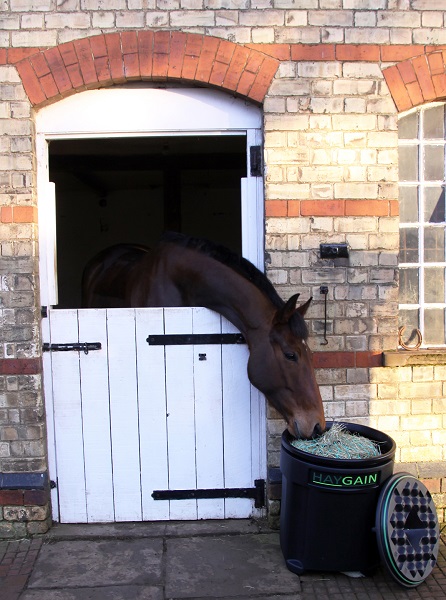Posted: 28th January 2019 | Back to news feed

Landmark study finds feeding Haygain steamed hay reduces the odds of Inflammatory Airway Disease by 65%
The breakthrough research found that horses with fungal elements in their airways have a 2.1 times greater chance of having Inflammatory Airway Disease (IAD) than horses with no fungi presence.

IAD affects huge numbers of horses and often goes undetected while also impacting their performance. The latest research by Dauvillier et al, published by The Journal of Veterinary Internal Medicine (JVIM) was carried out over a 3 year period with more than 700 horses being assessed, revealing that feeding Haygain steamed hay reduced the chance of horses developing IAD by 65%. It also found that horses fed dry hay had a 2.6 times increased chance of having fungi in the airways and that the degree of lower airway inflammation was significantly higher when horses were housed indoors and bedded on straw.
This work is the first to demonstrate a direct link between finding fungi in the airways, diagnosing IAD. The results indicate that fungal elements are commonly present in equine airways and that horses inhaling aerosolized fungal particles are at a significantly higher risk of having IAD.
What does a presence of fungi in the airways mean for the horse?
The presence of fungi in the airways has been directly linked to the development of IAD. Horses with fungal elements on the tracheal wash cytology, are 2.1 times more likely to develop IAD than horses with no fungi in their airways. A complaint of exercise intolerance was also more frequent in horses with tracheal wash fungal particles (23%) versus horses without. The presence of fungi in the airways is avoidable, meaning that IAD can be largely evaded with correct care and management, Haygain steamed hay playing the principal role in avoiding exposure to fungi.
This groundbreaking study found the degree of lower airway inflammation was significantly higher when horses were fed dry hay versus Haygain steamed hay. The study clearly identifies straw bedding and dry hay feeding as significant risks for IAD and for the presence of fungal elements in equine airways whereas Haygain steamed hay led to a reduction in the risk.
Inflammatory Airway Disease - all you need to know
The symptoms of IAD are nonspecific and can be subtle, which poses a diagnostic challenge and this study showed it is even more prevalent that we thought. A cough, poor performance and excess mucus within the airways on endoscopy is a key characteristic of IAD and should never be ignored. This disease differs from cases of Severe Equine Asthma (COPD/heaves), in that affected horses typically do not show increased respiratory efforts at rest.
Most, but not all horses with IAD will develop a cough that lingers but have no fever. Affected horses may be training fine but don’t perform well in competition and take longer to recover normal breathing but otherwise, horses with IAD appear bright and maintain their usual appetite.
The study
Several studies have shown that more than 80% of horses have Inflammatory Airway Disease and in this latest study a diagnosis was established in 88% of the cases assessed by an ambulatory internal medicine practice in Europe. The population of 731 horses was composed of 369 (50.5%) showjumpers, 87 (11.9%) dressage horses, 70 (9.6%) Thoroughbreds, 55 (7.5%) Standardbreds, 50 (6.8%) endurance horses, 35 (4.8%) eventers, and 65 (8.9%) leisure horses.
For each case, a clinical examination, an airway endoscopy, a tracheal wash (TW), and a bronchoalveolar lavage (BAL) were performed. Data regarding the type of bedding (straw, wood shavings, and other) and forage (dry hay, moistened hay, damped hay, steamed hay, or haylage) were systematically collected.
The key findings were:
- Horses with fungi in the tracheal wash (TW) cytology, are 2.1 times more likely to develop IAD than horses with no fungi
- The degree of lower airway inflammation was significantly higher when horses were housed indoors and bedded on straw versus shavings or when fed dry hay versus steamed hay.
- Horses fed dry hay had 2.6 times more chance of having fungi in their TW and 2.7 times more chance of being diagnosed with IAD whereas horses fed with steamed hay had 65% reduced odds of being diagnosed with IAD.
- The alternatives to dry hay other than steaming, such as wetting or soaking the hay, feeding haylage, or commercial“dust?free” hay all increased the risk of diagnosing IAD in this study.
- Soaking hay did not influence the finding of fungal elements in the TW; however, steaming hay in a Haygain decreased by 2?fold the risks of having fungal elements in the TW.
- Prevention is always better than cure and the latest findings continue to signify this importance
“We are very excited with the publication of the paper,” says co-author Dr Emmanuelle Van Erck-Westergren. “It’s the fruit of long years of research and we are really pleased with the outcome. Unlike papers that deal with small numbers of research horses, this paper reflects what happens in real conditions for our stables horses. It confirms what we have felt for years: rational management of the environment is paramount and in that perspective, Haygain hay steamers play an essential role. When we sample the airways, we can see what the horse actually breathes in in terms of particles and what response they trigger from the immune system. We relate what we see under the microscope to the symptoms we had in the horse but also to his environmental conditions. Horses on dry hay inhale high amounts of small particles that go deep in the lungs, including active fungal particles whereas horses on steamed hay have much clearer samples.”
There is now overwhelming evidence for the effectiveness of Haygain steamed hay in reducing inflammatory airway disease (IAD) and helping to improve respiratory health in horses.
“The recent published paper by Dauvillier et al., (2018) has confirmed what we have known for a long time - that steaming hay is best for horse respiratory health. We have proved many times that high-temperature steaming reduces airborne respirable dust in hay by >90% and kills fungi and bacteria, while preserving nutrients, and it is great to finally have this in vivo data to support our work,” says Professor Meriel Moore-Colyer, Director of Research and Knowledge Exchange at the Royal Agricultural University.
This study continually states that bedding on straw and feeding dry hay cannot be recommended for performance horses as they are significant risk factors for IAD. Soaking hay did not decrease the risk of IAD whereas the use of high?temperature hay steaming, in a Haygain, not only had a protective effect against the development of IAD but was the only effective way to prevent it.
About JVIM
The official publication of the ACVIM, the European College of Veterinary Internal Medicine, the European College of Veterinary Neurology, and the European College of Equine Internal Medicine.
The mission of the Journal of Veterinary Internal Medicine is to advance veterinary medical knowledge and improve the lives of animals by publication of authoritative scientific articles of animal diseases.
Who are ACVIM?
The American College of Veterinary Internal Medicine (ACVIM) is a non-profit organization dedicated to improving the lives of animals and people through education, training and certification of specialists in veterinary internal medicine, discovery and dissemination of new medical knowledge, and increasing public awareness of advances in veterinary medical care.
About Haygain
A range of hay steamers whose patented design is scientifically proven to reduce respirable dust in hay by up to 99%, kill bacteria and fungi producing a clean, palatable forage.

About Dr Emmanuelle Van Erck-Westergren
Experienced practice and company owner with a demonstrated history of working in the veterinary industry and research. Emmanuelle has become an opinion leader in veterinary equine sports medicine and is involved in several official sports organisations (FEI, FRSEB, ICEEP). She is a regular speaker at international conferences.

The Equestrian Index newsfeed is compiled from articles submitted by advertising members and expresses the opinions of those members. Watsons Directories Ltd shall not be held liable for any inaccuracies or mis-statements therein.